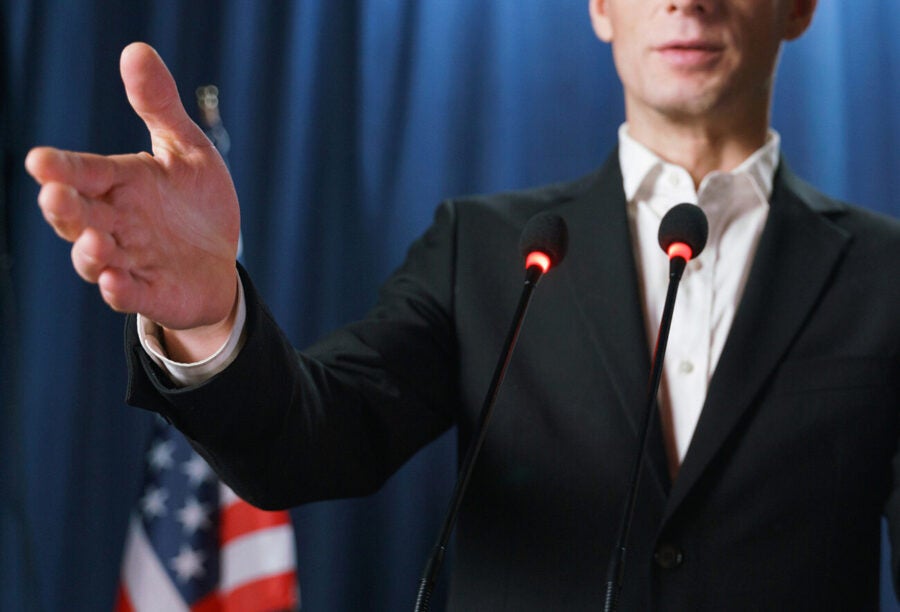In high-stakes presidential campaigns, every word a candidate utters matters. Speeches are often meticulously crafted and polished by teams of expert speechwriters. However, focusing solely on the words may not be enough to sway voters. According to a recent study co-authored by Dean Knox, Wharton professor of operations, information and decisions, together with Taylor Damann and Christopher Lucas of Washington University in St. Louis, the non-verbal elements of speech — such as tone of voice, pitch, and delivery — also play a key role in shaping voter perceptions and decisions.
Knox and his co-authors pored over 100 U.S. presidential campaign speeches to understand the impact of these non-verbal cues. Their findings suggest that how something is said can be just as important as what is said. This insight is particularly relevant as America approaches another presidential election, with global attention focused on the outcome of the November vote.
Knox explained: “People have been using spoken language to persuade others for centuries, shaping how we think, feel, and understand things. It’s not just about the words we choose, but also how we say them — our tone, emphasis, gestures, and facial expressions all play a big part in how our speech affects others.”
Tone of Voice and Delivery Can Dramatically Alter Voter Perception
The study’s implications are important, especially as it reveals that a candidate’s voice significantly influences voters’ perceptions of their passion, trustworthiness, and persuasiveness. Through two carefully designed experiments, the researchers demonstrated that subtle changes in vocal delivery could dramatically alter how a candidate is viewed by the electorate.
In the first experiment, the team played different variations in how candidates delivered key catchphrases for voters. In the second, they tested the influence of different vocal styles on listeners, using voice actors to control speech delivery. These experiments showed that using pauses, changes in pitch, and varying speech rhythms could capture attention and build anticipation, ultimately shaping how voters perceive a candidate’s energy and sincerity.
“Our tone, emphasis, gestures, and facial expressions all play a big part in how our speech affects others.”— Dean Knox
For example, a candidate who speaks with a varied pitch and strategic pauses might be perceived as more passionate and trustworthy compared to one who delivers a speech in a flat, monotonous tone. However, Knox cautioned that these perceptions may not necessarily reflect a candidate’s actual competence or integrity. “Since these vocal cues can be trained, they might influence our cognitive biases, especially during an election year, leading voters to potentially make skewed judgments,” he warned.
The study’s findings are not only important for voters but also for the candidates themselves, this year’s Democratic contender Kamala Harris and Donald Trump, a Republican. By understanding the impact of vocal style, candidates can learn to communicate more effectively with voters while staying true to their policy messages, the paper said. This insight might be particularly valuable for women candidates, who, according to the study, might face harsher judgments if they fail to communicate effectively.
Reassessing the Nuances of Voice in Political Communication
The research from Knox, Damann, and Lucas breaks new ground in understanding the nuances of political communication. While past studies have shown that voters prefer candidates with voices that are lower pitched, the co-authors found that other aspects, such as faster speech and more varied intonation, have an even greater impact on voter perception.
“Journalists and political strategists often highlight how important a candidate’s delivery is,” said Knox. “Our research shows that if you ignore those non-verbal elements, you end up with a skewed view of how effective a speech really is.”
The study was not without its challenges. The authors acknowledged the difficulty in measuring and understanding all the ways vocal style affects listeners, given the constantly evolving methods and tools used in such research.
Furthermore, previous studies on this topic have yielded conflicting results. Knox noted that adding basic audio measures, like average pitch, to text-based studies might seem helpful, but it can actually be misleading. Changes in pitch often affect other factors, such as volume, which in turn can influence how listeners react.
“Our research shows that if you ignore those non-verbal elements, you end up with a skewed view of how effective a speech really is.”— Dean Knox
A New Approach to Studying Speech
To overcome these challenges, Knox, Damann, and Lucas developed an alternative method by comparing pairs of speech excerpts with identical words but different vocal styles. For example, they examined political speeches where candidates repeated the same catchphrases, sometimes with more energy and sometimes more flatly. However, they found that this method couldn’t fully separate the impact of individual elements like pitch and speed.
As a solution, they directly manipulated elements of speech, such as volume, using audio-editing software. While this allowed researchers to isolate the effect of specific speech elements, it had its own limitations, as it couldn’t fully capture the natural nuances of human speech. To address this, the researchers also enlisted 10 voice actors to naturally vary the tone and speed of speeches, offering a closer approximation to real-life speech, albeit with less control.
“The combination of artificial and natural adjustments provided a fuller understanding of how speech impacts listeners,” Knox said.
This approach opens up new avenues for exploring the role of AI-generated speech in political communication — a fascinating research question that remains to be fully explored.
As voters head to the polls in November, this study serves as a reminder that the power of speech extends far beyond the words themselves. The way a candidate speaks — through tone, pitch, and delivery — can significantly shape public perception and, ultimately, the outcome of an election.



